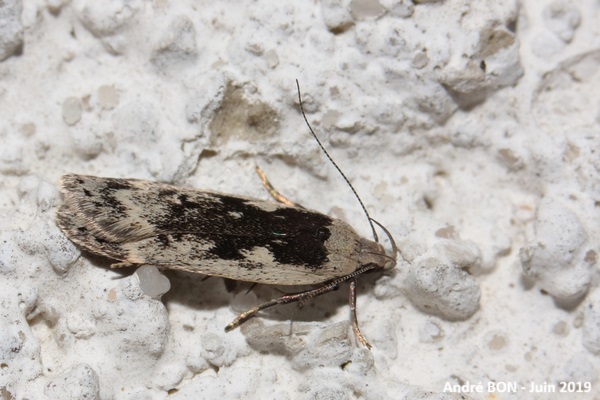

| Anacampsis blattariella (Hübner, 1796) |


|
|
Scientific name: Anacampsis blattariella (Hübner, 1796) Common name: French name: Order: Lepidoptera Suborder: Microlepidoptera Family: Gelechiidae Subfamily: Anacampsinae Wingspan: 16-19 mm. Biotope: Areas with Birches. Adults often land on trunks during their diurnal rest. Geographic area: Almost all Europe, except in the Iberian Peninsula and in Ireland. Flight time: Late June to September. Number of generations : 1 Caterpillar: Pale green or pale yellowish with black spots. The head and the prothoracic plate are shiny black. These caterpillars grow in May-June and shelter inside a leaf longitudinally rolled along the middle rib. Host plant: Birches (Betula). |
The micro-moths of the Gelechiidae family show long labial palps which are strongly curved upwards. Anacampsis blattariella shows elongated fore wings, with rounded apex and spotted with black and white. These colours provide an efficient camouflage on the bark of Birches. The area close to the costal edge is white and powdered with some black scales. The area close to the inner edge is a darker colour. The centre of the wings is marked with large black patches on the two third of the wing length. You can distinguish a white submarginal stripe preceding a more greyish area marked with small black marginal spots, not always very visible. The hind wings are dark grey. It is not possible to tell Anacampsis blattariella apart form the similar species, Anacampsis populella, on picture. The proximity of the host plants is the easiest criteria to get one indication. The caterpillars of Anacampsis populella grow on Poplars (Populus) and Willows (Salix). |
| [To know more about the Anacampsis blattariella] [Next picture] [Top] |

|
I have listed this micro-moth as Anacampsis blattariella because I have observed it very close to one Birch. |
| [To know more about the Anacampsis blattariella] [Previous picture] [Top] |

|
Here is a new observation in the same place as 7 years ago. There is still the same Birch less than 10 meters away and no one has planted any Poplar or Willow in the area. So I stick to the same species identification. |